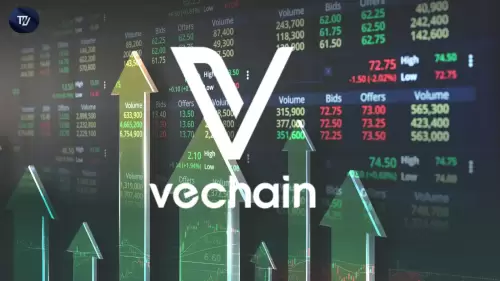 |
|
 |
|
 |
|
 |
|
 |
|
 |
|
 |
|
 |
|
 |
|
 |
|
 |
|
 |
|
 |
|
 |
|
 |
|
暗号、AIトレーニング、および地方分権の交差点の調査:データ調達から規制枠組み、およびHuaweiのAIの進歩まで。
Crypto, AI Training, and Decentralization: A New Era?
暗号、AIトレーニング、および地方分権化:新しい時代?
The convergence of crypto, AI training, and decentralization is creating ripples across industries. Let's dive into the latest developments.
暗号、AIトレーニング、および分散化の収束により、業界全体に波紋が生まれています。最新の開発に飛び込みましょう。
Decentralized Data for AI: The New Gold Rush
AIの分散データ:新しいゴールドラッシュ
The AI world is facing a data drought. Forget compute power; high-quality, legally compliant data is the new bottleneck. Poseidon, backed by a16z Crypto, is tackling this head-on with a decentralized data layer. Their $15 million seed funding aims to solve the scarcity of IP-cleared training data, especially crucial for fields like robotics and spatial computing. Poseidon uses decentralized infrastructure to legally source and distribute data sets, ensuring traceability and monetization for contributors. This decentralized approach may be the only way to efficiently orchestrate the data creation and curation needed at scale. The early wave of AI models thrived on easily accessible online data, but that era is over. Now, the challenge is coordination: thousands of contributors must work together to source, label, and maintain the physical data that next-gen AI needs.
AIの世界はデータの干ばつに直面しています。計算能力を忘れてください。高品質の法的に準拠したデータは、新しいボトルネックです。 A16Z Cryptoに裏付けられたPoseidonは、分散型のデータレイヤーでこの正面に取り組んでいます。彼らの1500万ドルのシード資金は、特にロボット工学や空間コンピューティングなどの分野にとって重要なIPクリアされたトレーニングデータの希少性を解決することを目的としています。 Poseidonは、分散型インフラストラクチャを使用して、データセットを合法的に調達および配布し、貢献者のトレーサビリティと収益化を確保します。この分散型アプローチは、大規模に必要なデータの作成とキュレーションを効率的に組織化する唯一の方法かもしれません。 AIモデルの初期の波は、簡単にアクセスできるオンラインデータで繁栄しましたが、その時代は終わりました。現在、課題は調整です。何千人もの貢献者が協力して、次世代AIが必要とする物理データを調達、ラベル付け、維持する必要があります。
India's Crypto Regulation: A Balanced Approach?
インドの暗号規制:バランスの取れたアプローチ?
India is stepping up its crypto game with the proposed COINS Act. This model law seeks to balance innovation with oversight, focusing on digital asset rights and establishing clear regulations. A key aspect is the emphasis on "crypto-native constitutional rights," like self-custody and financial privacy. The Act proposes a new regulatory body, the Crypto Assets Regulatory Authority (CARA), to oversee crypto activities. While centralized exchanges would face strict licensing, decentralized protocols would have a lighter disclosure regime. The plan also includes a "safe harbor" for Indian ICOs and a Strategic Bitcoin & Crypto-asset Reserve, positioning India as a strong player in the global crypto market.
インドは、提案されたコイン法で暗号ゲームを強化しています。このモデル法は、イノベーションと監視、デジタル資産の権利に焦点を当て、明確な規制を確立することを目指しています。重要な側面は、自己義務や金融プライバシーなど、「暗号出身の憲法上の権利」に重点を置くことです。この法律は、暗号活動を監督するために、新しい規制機関である暗号資産規制当局(CARA)を提案しています。集中型取引所は厳格なライセンスに直面しますが、分散型プロトコルにはより軽い開示制度があります。この計画には、インドのICOのための「安全な港」と戦略的なビットコイン&クリプトアセットリザーブも含まれており、インドはグローバルな暗号市場の強力なプレーヤーとして位置付けられています。
Huawei's AI Breakthrough: AsyncFlow
HuaweiのAIブレークスルー:asyncflow
Huawei is making waves with AsyncFlow, an AI training framework designed to dramatically improve the speed and scalability of post-training processes for large language models (LLMs). AsyncFlow introduces an asynchronous streaming reinforcement learning architecture, overcoming limitations of traditional methods. At its core is TransferQueue, a distributed data management module that balances workloads and allows overlapping of processing stages. This results in significant throughput gains, potentially leading to substantial savings in time and infrastructure costs. Industries like healthcare, finance, and autonomous driving could see direct performance enhancements. Huawei's broader AI strategy also includes open-sourcing its programming language, Cangjie, reducing reliance on foreign technology and building a homegrown ecosystem.
Huaweiは、大規模な言語モデル(LLM)のトレーニング後のプロセスの速度とスケーラビリティを劇的に改善するように設計されたAIトレーニングフレームワークであるAsyncFlowで波を作っています。 Asyncflowは、非同期ストリーミング強化学習アーキテクチャを導入し、従来の方法の制限を克服します。そのコアには、ワークロードのバランスをとり、処理段階の重複を可能にする分散データ管理モジュールであるTransferqueueがあります。これにより、スループットが大幅に向上し、時間とインフラストラクチャコストが大幅に節約される可能性があります。ヘルスケア、財務、自律運転などの産業は、直接的なパフォーマンスの向上を見ることができます。 Huaweiのより広範なAI戦略には、プログラミング言語であるCangjieのオープンフォーシング、外国の技術への依存度の低下、自家製のエコシステムの構築も含まれます。
Tether's Enforcement Role: A Double-Edged Sword
テザーの執行役割:両刃の剣
Tether, the issuer of USDT, has been actively freezing funds linked to illicit activity, collaborating with law enforcement. While this demonstrates a commitment to combating financial crime, it also raises concerns about centralization. Critics argue that such actions could undermine the core crypto values of financial sovereignty and decentralization, potentially resembling a central bank digital currency (CBDC). However, others argue that centralized control can be beneficial in certain situations, such as recovering stolen funds. Tether has frozen over $2.5 billion in USDt linked to illicit activity and has blocked more than 2,090 wallets in cooperation with global authorities. This power to freeze user funds sparks debate within the crypto community.
USDTの発行者であるテザーは、違法行為に関連する資金を積極的に凍結し、法執行機関と協力しています。これは金融犯罪との闘いへのコミットメントを示していますが、集中化に関する懸念も提起します。批評家は、そのような行動は、中央銀行のデジタル通貨(CBDC)に似た潜在的に、財政的主権と地方分権の中心的な暗号価値を損なう可能性があると主張しています。しかし、他の人は、盗まれた資金の回復など、特定の状況で中央の管理が有益であると主張しています。テザーは、違法行為にリンクされた25億ドル以上のUSDTを凍結し、グローバル当局と協力して2,090を超えるウォレットをブロックしました。ユーザー資金を凍結するこの力は、暗号コミュニティ内での議論を引き起こします。
Personal Thoughts
個人的な考え
The intersection of crypto, AI, and decentralization is a complex and evolving landscape. While decentralized solutions like Poseidon offer promising ways to source high-quality AI training data, regulatory frameworks like India's COINS Act are crucial for fostering responsible innovation. Huawei's AI advancements demonstrate the potential for cutting-edge technology, but the centralized control exhibited by entities like Tether raises important questions about the future of crypto and decentralization. For instance, Tether's ability to freeze funds, while helpful in some cases, underscores the lack of true decentralization in many stablecoins. This suggests that while the crypto world aims for decentralization, real-world compliance and security needs often necessitate centralized control.
暗号、AI、および分散化の交差点は、複雑で進化する景観です。 Poseidonのような分散型ソリューションは、高品質のAIトレーニングデータを調達するための有望な方法を提供しますが、インドのコイン法のような規制の枠組みは、責任ある革新を促進するために重要です。 HuaweiのAIの進歩は、最先端の技術の可能性を示していますが、Tetherのようなエンティティによって示される集中管理は、暗号と分散化の将来について重要な問題を提起します。たとえば、テザーの資金を凍結する能力は、場合によっては役立つが、多くの馬鹿げた地方の真の分散化の欠如を強調している。これは、暗号の世界が地方分権化を目指している一方で、現実世界のコンプライアンスとセキュリティのニーズはしばしば集中管理を必要とすることを示唆しています。
Wrapping Up
まとめます
So, what's the takeaway? The crypto, AI, and decentralization trifecta is full of potential, but also presents challenges. It's a wild ride, but hey, at least it's never boring!
それで、持ち帰りは何ですか?暗号、AI、および地方分権化三連部は、可能性に満ちていますが、課題も提示しています。それはワイルドライドですが、ちょっと、少なくとも退屈することはありません!
免責事項:info@kdj.com
提供される情報は取引に関するアドバイスではありません。 kdj.com は、この記事で提供される情報に基づいて行われた投資に対して一切の責任を負いません。暗号通貨は変動性が高いため、十分な調査を行った上で慎重に投資することを強くお勧めします。
このウェブサイトで使用されているコンテンツが著作権を侵害していると思われる場合は、直ちに当社 (info@kdj.com) までご連絡ください。速やかに削除させていただきます。





























































